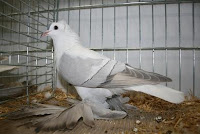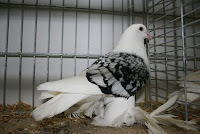The Swallow Pigeon is a variety of domestic pigeon breeds with a distinctive marked pattern. This pattern is basically a white pigeon with colored wings and a small marking of color on the front and top of the head. One distinction of swallow pigeons from other pigeons is that the back and shoulders are white and not colored but the wings are colored. This marking forms a saddle or white heart shape on the back.
The Swallow Pigeons size and body shape is that of a basic wild type pigeon sometimes referred to as “common pigeon” or “field pigeon”. Some Swallow Pigeons have been developed with showy feather ornaments. These are mainly feathered feet (muffs) and crests upon their heads.
The appearance of swallow pigeon is strong, full body, medium to low standing, field pigeon type, heavily muffed, shell crested or smooth headed. All parts are balanced. The head is long, curved, with forehead reasonably high, smooth headed or crested. Wider at the back of the skull for those birds with shell crest. Size of the head must be in proportion to the size of the body. In crested birds, the shell is round, thick and ending on both sides in well-defined rosettes. Eyes are dark (bull), eye cere small, with skin color flesh color to red, fine in texture. The beak is moderately long. Beak markings on reds and yellows are flesh color, on blacks the upper beak is black, on blue the beak is blue-black to black, on silver the beak is light horn colored (found mostly toward the front of the beak), lower beak flesh color for all feather colors. The neck is medium in length, full where the neck joins the body, with the throat well cut out (No gullet). The breast is broad, full underneath, well-rounded in appearance from the front, somewhat protruding and covering the wing butts. The back is long, broad at the shoulders tapering to the tail and slightly sloping (approximately a 15 degree slope). The wings are powerful, wide feathered and not crossing at the tail. Held tight to the body. Secondary feathers should touch over the rump (closed back). The tail is moderately long, well closed (approximately 1-1/2 feather width) and not touching the floor. The legs and feet have low posture, long and thickly muffed feet with three layers of feathers laying flat, having a sickle shaped curve blending into the hock feathers. Shape of foot feather is more important than length. Feathers are firm, smooth and dense feathering.
Color Patterns:
Black, red, yellow, blue, silver, all without bars, with white bars, or spangled; blue with black bars, silver with dark dun bars, blue and silver checkered. Ash red and cream with or without dark bars. The feather color in blue, silver, ash red and cream, light in color, clear and even; in black, red and yellow, rich, intense color with good sheen, clear and even.
Markings:
The Spot Marking on the wing pigeon (Silesian and Fairy) should be symmetrical, pear shaped and not to extend beyond its highest point on the top of the head at a point between the center of the eyes. The color of the spot should not extend to the eye cere. The spot should be narrower at the base and should not extend to the corner of the mouth.
The Cap Marking on the Swallow (Fullhead) should cover the top of the head starting between the upper and lower mandible and extend in a straight line to the lower part of the eyes, then continuing in a straight line to the rosettes at the ends of the crest (note that this does not say that the cap marking runs in a straight line from the beak to the rosettes). The cap marking should extend to the crest, but not into the crest. White barred Swallows in blue and silver must have a clear, distinct narrow dark edging.
MAJOR FAULTS
Head and Neck: Lack of rosettes, stained lower beak, lack of color on upper beak of black, blue or silver, broken or cracked eyes, beetle brow, stained eye cere, gullet, color of cap in full head not reaching crest, base of spot extending to the mouth in spot swallow, color of spot extending to eye.
Body, Wings and Tail: Weak body, body too long, body too short, wing butts not well covered, side boards, too broad or broken bars, bar touching at top of wing, laced pattern in spangles, wing tips carried below tail, less than twelve (12) tail feathers, soft or loose feathering, roached back.
Legs, Feet and Muffs: Weak feathered muffs, split muffs, grizzled foot feathers, station too low or too high.
From this basic pattern many sub varieties of Swallow Pigeons have been developed. The following is a list of these varieties and note that their names indicate their place of origin.
Nuremberg Swallow : Maybe the oldest type of Swallow is a little larger than other types of swallows and comes in fewer colors but known for it’s very rich colors. It is always with very short-feathered feet. It has a full cap of color on the head and a crest.
Thuringian Swallow : Very similar to the Nuremberg Swallow but with no feathers on the feet. These come with a crest and without the crest with a full cap marking on the head. These also have more color varieties than Nuremberg Swallows.
Saxon Swallow : A little smaller than the two above. This variety has much heavier and longer feathered feet. It has a full cap marking and always with a crest which wraps around the back of the skull and ends on each side with a rosette. The cap marking must terminate at the point where the crest feathers rise up on the back of the skull.
Saxon Fairy Swallow : In Germany called the Saxon Wing pigeon. Is similar in size to the Saxon Swallow. The Saxon Fairy Swallow differs in that the marking on the head is a spot of color on the forehead and not the full cap marking. The Saxon Fairy Swallow is always shell crested.
Silesian Swallow or Saxon Shield Pigeon : Very similar to the Saxon Fairy Swallow but has a smooth head (without the shell crest). Also called Saxon Wing Pigeon in Germany.
Thuringian Spot Swallow : Also called Thuringian Wing Pigeon in Germany. They are clean legged (no muffs) and come plain-headed or crested.
Tiger Swallow Or Bohemian Swallow : Always come with the alternating colored and white flight feathers. Which is achieved by stimulating colored feathers to turn white after plucking the appropriate feathers. These come with either muffs or clean legged and either full cap marking or spot marking and plain headed or crested.























0 comments:
Post a Comment